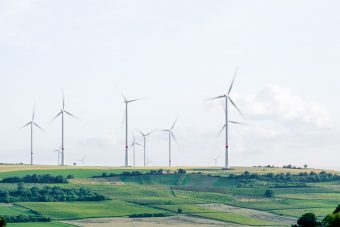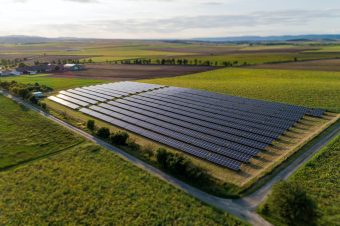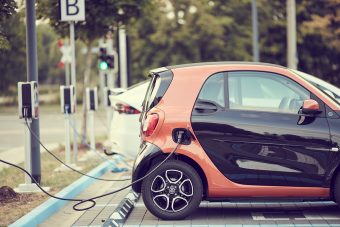
The world must rapidly cut its greenhouse gas emissions. Remarkable progress has been made, especially in the adoption of renewable energy in the transport and energy sectors, but the change is not happening fast enough to meet global net-zero ambitions. What is the hold-up and what can we do to accelerate the energy transition?
The need to move away rapidly from fossil fuels and fossil raw materials is now embedded in global diplomacy, national and corporate targets and public consciousness. At COP28, nations agreed to “transition away from fossil fuels,” triple global renewable energy capacity and double the rate of energy efficiency improvements.
Yet, despite all the efforts to move away from fossil fuels, greenhouse gas emissions reached record levels in 2023, according to the Global Carbon Budget.
“Is the energy transition happening fast enough to avoid a climate crisis? Clearly not,” says Eliot Whittington, Chief Systems Change Officer at the Cambridge Institute of Sustainability Leadership. “The power side of the transition is going extremely quickly and it’s accelerating. And we’re getting there on road transport, particularly light vehicles. But everywhere else, it’s not happening fast enough, in sectors such as steel, cement, shipping and aviation.”
Carrie Song, Senior Vice President for Renewable Products at Neste, adds: “There are economic, political, technological and social reasons that emissions are not falling fast enough. Investment in renewables and other lower-carbon technologies is growing, but not at the level required to enable us to achieve the complete energy transition towards more sustainable alternatives. And, investments in fossil fuel infrastructure are continuing, locking in emissions for decades to come.”
So, while the green transition is underway, it’s clear that this shift is dependent on a complex web of factors that must be understood and dealt with holistically to arrive at a new world order for energy as effectively and fairly as possible.
As the tide slowly changes, let’s look at the technologies that are needed, the bottlenecks in electrification, the role of consistent regulation worldwide and how a just transition is crucial long term.
The technologies changing the global energy foundation
Alongside new alternatives for fossil raw materials, many technologies that enable a complete energy transition exist but have yet to reach maturity.
Strides are being made to develop innovative and stable energy storage solutions, critical to boost battery storage capacity and to enable the long-term storage and long-distance transport of non-fossil energy, such as green hydrogen.

Technological developments are needed in industries that produce significant greenhouse gas emissions, which are difficult to transition away from fossil fuels too. This includes ‘Power-to-X’, which makes hydrogen from water using electricity. When renewable electricity is used this produces renewable or green hydrogen, with a low carbon footprint. This green hydrogen, together with carbon dioxide from captured CO2 emission sources, could transform carbon-intensive industries, such as steelmaking and cement, and has exciting potential applications for aviation.
Another tool for cutting emissions in hard-to-abate industries is carbon capture, utilization and storage (CCUS), which enables emissions reductions where other options are impractical or too costly.
Electrification bottlenecks
For many sectors, the well-known answer to transitioning away from fossil fuels is a switch to electrification from renewable sources. A bottleneck to this is the slow pace of grid upgrades to allow more renewable energy capacity onto the network. “Everyone likes renewable energy in the abstract until developers try to build it near your house,” says Samantha Gross, Director of the Energy Security and Climate Initiative at The Brookings Institution.
For cars and light commercial vehicles, electrification works because these vehicles carry light loads for short distances and can recharge often. It’s a different story for aviation and shipping and heavy machinery in remote locations. They are heavy, carry large loads and can not stop frequently to recharge.
Where electrification is challenging, there are other alternatives to fossil fuels, such as renewable diesel and sustainable aviation fuel (SAF). These are an effective drop-in solution with an immediate impact on emissions, but, while there are low upfront costs, the higher price compared to fossil fuels can still be a barrier. “Renewable fuels, such as SAF, can be three to four times more expensive, but we need to look at why that is. Conventional fossil fuels don’t include the cost of emissions, local air pollution and other problems. Having said this, we are only talking about an added cost of what amounts to a couple of euros per passenger, the same that many pay for a coffee at the airport,” says Song.
“In the wealthy world, a lot of this is a marketing problem,” Gross adds. “If you present something as a sacrifice, it doesn’t sell. You need to sell this as going somewhere better.”
More:
- Investment in Clean Energy This Year is Set to be Twice the Amount Going to Fossil Fuels
- After Slight Rise In 2023, Methane Emissions From Fossil Fuels Are Set To Go Into Decline Soon
- When Ecology and Energy Transition Aren’t on the Same Team
Consistent regulation and investment drive the energy transition
There is little consensus on the best approach to removing fossil fuels from the energy system and regulation is uneven in different parts of the world.
“Policies to encourage the energy transition are still insufficient and inconsistent across different cities, countries and regions,” Song says. “And, they often have to compete with fossil-fuel-friendly policies. We need clear, consistent, ambitious policies to drive continued investment and to encourage businesses to make the right decisions.”

Neste has invested EUR 1.6 billion (USD 1.73 billion) to double the annual renewables capacity at our Singapore refinery and EUR 0.9 billion to establish a joint operation and expand renewables production capacity on the US West Coast. We also have a EUR 1.9 billion renewables production capacity expansion project at our Rotterdam refinery. And, we have a EUR 2.5 billion investment programme at our Porvoo refinery in Finland to turn it into a leading renewable and circular solutions refining hub capable of producing annually about 3 million tons of renewable and circular products, such as renewable diesel, SAF and renewable and circular feedstock for the polymers and chemicals industry.
“The payback for these investments will take many years, so if you want companies to make investments on that scale, you need to give such large-scale suppliers confidence that there will be long-term demand for their products,” says Song. “That means we need to see clear, consistent policies that will drive investment.”
We are seeing green shoots of such regulations and policies with the European Union’s mandate that at least 14 percent of energy in transport should come from renewable sources by 2030, including a minimum share of 3.5 percent of advanced biofuels and another regulation mandating an increasing share of SAF to be blended into jet fuel in Europe, starting with 2 percent in 2025 and increasing to 70 percent in 2050. Another example is California’s Low Carbon Fuel Standard, designed to reduce the CO2 intensity of the state’s fuel mix. As a result, more than half of the diesel sold in California is renewable. At a national level in the U.S., the Inflation Reduction Act drives billions of dollars of investment across the clean economy.
But, a study by the Climate Policy Initiative and law firm Allen & Overy estimates that almost EUR 184 trillion of investment is needed for the world to reach net zero by 2050, or more than EUR 5.5 trillion a year to 2030 and more than EUR 6.4 trillion every year from 2030 to 2050. Only EUR 920 billion was invested in this area in 2022, suggesting a massive investment gap to be filled.
“This is really hard. It’s one of the biggest transformations mankind has tried to do. The level of investment needed to completely change the energy system that underlies the entire economy is gigantic,” says Gross.
A just transition: taking it slower to get it right
Any change impacts people, their lives and their futures – this has to be taken into account in a transition that will extinguish entire industries, turn others upside down and create new ones.

The energy transition must be a just transition as envisaged by the Paris Agreement: one which delivers green and decent jobs and creates resilient communities. “If we lose the public, we are sunk. If you go too fast, you won’t get buy-in from people and then everything stops,” Gross says. “In many countries, particularly in emerging markets, the focus is on lifting living standards and incomes, not cutting emissions.”
Hundreds of millions of people still lack access to energy, while billions have no access to modern cooking fuels. “Any solution that does not have them developing is not a solution. But they can do so without damaging the environment as much as we did,” says Gross.
Another challenge is that the green economy is capital-intensive to get going. Operators must spend a lot of money upfront, a challenge, particularly for poorer countries. This upfront expenditure has risen even more as inflation has surged and interest rates shot up, creating challenges for project developers.
The increase in the cost of living also impacts individual consumers for whom spending on sustainable alternatives is a luxury that they cannot afford or are not willing to prioritize.
Finally, geopolitical instabilities also hamper progress on sustainability goals, as security, defence and warfare take a greater share of the world’s attention – and money.
It is easy to fall into pessimism. The challenges with moving away from fossil fuels and fossil raw materials are considerable. There are many moving parts to consider – none easy to tackle nor possible to be solved in isolation. Given the enormity of the task, it’s probably wrong to ask how we can accelerate the energy transition. The key is to get it right.
There have been huge success stories in renewable fuel development, renewable energy, energy storage and electric vehicles. This gives hope that we might observe a snowball effect in the transition away from fossil resources, picking up pace and scale, while crucially, ensuring it’s done in a way that is just and sustainable long term.
Source: World Economic Forum

